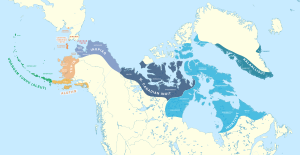
Back Eskimo-Aleoetiese tale Afrikaans Luengas esquimalaleutianas AN اللغات الإسكيمو أليوطية Arabic Llingües esquimo-aleutianes AST Eskimos-aleut dilləri Azerbaijani اسکیمو-آلوت دیللری AZB Эскімоска-алеуцкія мовы Byelorussian Эскімоска-алеуцкія мовы BE-X-OLD Ескимоско-алеутски езици Bulgarian এস্কালেউট ভাষা Bengali/Bangla
| Eskaleut | |
|---|---|
| Eskimo–Aleut Inuit–Yupik–Unangan | |
| Geographic distribution | Alaska, Northwest Territories (Inuvialuit Settlement Region), Nunavut, northern Quebec (Nunavik), northern Labrador (Nunatsiavut), Greenland, far eastern Russia (Chukotka Peninsula) |
| Linguistic classification | One of the world's primary language families |
| Proto-language | Proto-Eskaleut |
| Subdivisions | |
| ISO 639-5 | esx |
| Glottolog | eski1264 |
 Eskaleut languages are spoken in Russia, Alaska, Canada and Greenland | |
The Eskaleut (/ɛˈskæliuːt/ e-SKAL-ee-oot), Eskimo–Aleut or Inuit–Yupik–Unangan languages are a language family native to the northern portions of the North American continent, and a small part of northeastern Asia. Languages in the family are indigenous to parts of what are now the United States (Alaska); Canada (Inuit Nunangat) including Nunavut, Northwest Territories (principally in the Inuvialuit Settlement Region), northern Quebec (Nunavik), and northern Labrador (Nunatsiavut); Greenland; and the Russian Far East (Chukchi Peninsula). The language family is also known as Eskaleutian, Eskaleutic[1] or Inuit–Yupik–Unangan.[2]
The Eskaleut language family is divided into two branches: Eskimoan and Aleut. The Aleut branch consists of a single language, Aleut, spoken in the Aleutian Islands and the Pribilof Islands. Aleut is divided into several dialects. The Eskimoan languages are divided into two branches: the Yupik languages, spoken in western and southwestern Alaska and in Chukotka, and the Inuit languages, spoken in northern Alaska, Canada and Greenland. Inuit languages, which cover a huge range of territory, are divided into several varieties. Neighbouring varieties are quite similar, although those at the farthest distances from the centre in the Diomede Islands and East Greenland are quite divergent.[3]
The proper place of one language, Sirenik, within the Eskimoan family has not been settled. While some linguists list it as a branch of Yupik,[4] others list it as a separate branch of the Eskimoan family, alongside the Yupik and Inuit languages.[5]
- ^ Cf. Fleming 1987:189.
- ^ "Due to the pejorative nature of the term 'Eskimo' in some locales, and the increasing preference for 'Unangan' as opposed to 'Aleut' in Alaska, this family may be alternately referred to as Inuit–Yupik–Unangan. The hyphenated term gives some sense of the variety of languages subsumed under this family label." Holton, Gary. 2012. Overview of Comparative Inuit–Yupik–Unangan. Retrieved 2013-11-18.
- ^ Kaplan, Lawrence (1984). McGary, Jane (ed.). Inupiaq and the Schools – A Handbook for Teachers. Alaska Native Language Center, University of Alaska Fairbanks.
- ^ "Ethnologue report for Yupik Sirenk", Ethnologue, Retrieved 2008-08-25.
- ^ "Alaska Native Languages – An Overview" Archived 2008-05-09 at the Wayback Machine. Retrieved 2008-08-25.
© MMXXIII Rich X Search. We shall prevail. All rights reserved. Rich X Search